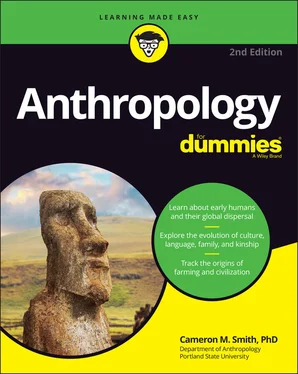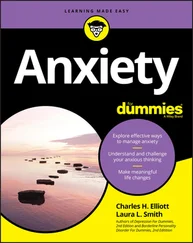In 1949, anthropologist Clyde Kluckhohn published “Mirror for Man,” an introduction to the study of anthropology , the study of humanity ( anthro meaning “of humanity” and logy meaning “the study of”). Since then, attitudes have changed a little (most people now speak of “humanity” rather than “mankind”), but Kluckhohn’s words still ring true: “Anthropology holds up a great mirror to man and lets him look at himself in his infinite variety.”
Anthropology is the mirror of our species; a place for humanity to reflect on itself. But you have to do that looking, and the discovering that comes from it, with care. If you want to understand anything, you need to see everything, warts and all. As a species we’ve found time and again that our cultural biases — our ethnocentric way of thinking that our culture is superior to all others — are simply wrong; humanity has found many ways to be human. Anthropology studies those many paths.
What does humanity see in the great mirror of anthropology? Before answering this question, you need to understand where anthropology came from. It didn’t just pop up out of nowhere, and it wasn’t invented overnight: It was cobbled together, refined, reinvented, crafted, and then reimagined and reinterpreted such that today anthropology is a very diverse field holding up many mirrors for humanity.
Instead of giving you the whole history of anthropology — which would take a separate book — in this chapter I introduce the main ideas that paved the way to modern anthropology. As with any idea, you see that some were specific products of their times and have since fallen by the wayside, while others were more lasting, and continue to fascinate anthropologists today.
Getting to the Heart of Anthropology
An exciting passage of Homer’s Odyssey finds Odysseus and crew spying distant figures on an island they’re about to land on and wondering about the people they’ll encounter. Do those strange folk plant crops in an orderly fashion, or do they forage for their food? Do they revere the gods and have laws and lawful assemblies? Or are these some other kind of people — savages, maybe? Savages, of course, would be people who didn’t do things the Greek way …
Homer wrote nearly 3,000 years ago, but the questions Odysseus asked were already ancient. Look, over there: People different from us! What are they like?
Anthropology is rooted in the question of what Other (with a capital O ) people are like. But up from the roots has grown a whole plant, an anthropology that not only looks at Others but shows how we can examine ourselves. Anthropologists today continue to learn about the human species by studying people outside Western civilization, but they also scrutinize humanity as a biological species, investigate how the modern world came to be by examining the past, and obsess over details of uniquely human characteristics such as language. Anthropologists have even taken up the study of anthropology itself , some saying, in effect, that the mirror is cracked and that to understand humanity better, they must understand the history of anthropology itself.
By examining the history of their own discipline, anthropologists have gone from silvering the mirror — applying the reflective coating to the glass — to gluing “broken mirrors” (outdated anthropological ideas) back together to be more relevant in modern times and, today, trying to keep the mirror clean by being careful with our assumptions. Because culture can change so quickly, the very questions that each generation of anthropologists asks themselves tend to change, so maintaining this mirror for humanity isn’t easy. In fact, some would say that each generation has its own mirror, and that questions should change as culture changes.
There is likely room for some of each of these approaches. As times change and we learn new things, we need to ask new questions. But at the same time, I’m confident that the following topics will always be central to humanity’s investigation of itself — to the field of anthropology:
What are the commonalities among humans worldwide? That is, what does every human culture do?
What are the variations among humans worldwide? That is, what things do only some cultures do?
Why do these commonalities and variations exist in the first place? In other words, why aren’t all human cultures and behaviors the same?
How does humanity change through time? Are we still evolving, and if so, how?
Where has humanity been, and what can that show us about where humanity is going? That is, what can we learn about ourselves today, from our past?
To answer these and other questions, one foundation of anthropology is the comparative approach, in which cultures aren’t compared to one another in terms of which is better than the other but rather in an attempt to understand how and why they differ as well as share commonalities. This method is also known as cultural relativism , an approach that rejects making moral judgments about different kinds of humanity and simply examines each relative to its own unique origins and history.
Because humanity qualifies as one of many biological species in the animal kingdom, another foundation of anthropology is evolution , the change of species through time. As I discuss throughout this book, both human biology and culture have evolved over millions of years, and they continue to evolve. What’s more, human biology can affect human culture, and vice versa. For example, over time, human brains became larger (biological change) leading to increased intelligence, language, and, eventually, writing (a cultural change in the way humans communicate). Anthropologists call human evolution biocultural evolution to illustrate this dual nature of human change.
 Beware of the idea that you always have to choose just one answer to a question; it may be that the answers of an “either/or” question aren’t the only possible answers. And, it’s possible that neither answer is right! This is the problem of the “false choice,” and I use it often, thinking, “Wait a minute, are these really the only two possibilities? Couldn’t there be another?”
Beware of the idea that you always have to choose just one answer to a question; it may be that the answers of an “either/or” question aren’t the only possible answers. And, it’s possible that neither answer is right! This is the problem of the “false choice,” and I use it often, thinking, “Wait a minute, are these really the only two possibilities? Couldn’t there be another?”
Dazed and Confused: What It Is to Be Human
One big problem with being human is that it leads to questions. One of the biggest of all questions is just what we humans are. How do we fit in with the rest of the universe? Eighteenth-century German philosopher Immanuel Kant wrote that three fundamental questions were “What can I know? What ought I to do? What may I hope?” Just like Rene Descartes’ momentous phrase “I think, therefore I am,” each of Kant’s little nuggets can lead to a lifetime of introspection. If anthropology is a mirror for humankind, the individual human mind is itself a hall of mirrors. It’s a wonder we can make any sense of anything!
To get anywhere, you need to start with some definitions. These terms come up throughout this book, so it’s important to get a handle on them sooner rather than later.
In anthropology, humanity refers to the human species, a group of life forms with the following characteristics:
Bipedalism (walking on two legs)
Relatively small teeth for primates of our size
Relatively large brains for primates of our size
Using modern language to communicate ideas
Using complex sets of ideas — called culture (discussed later) — to survive
Standing on two legs and having particularly small teeth and large brains are all anatomical characteristics, and they’re studied by anthropologists focusing on human biological evolution. Surviving by using a wide array of cultural information (including instructions for making a fur cloak in the Arctic or a pottery canteen in the desert Southwest) are behavioral characteristics. Each requires different kinds of anthropology to understand.
Читать дальше

 Beware of the idea that you always have to choose just one answer to a question; it may be that the answers of an “either/or” question aren’t the only possible answers. And, it’s possible that neither answer is right! This is the problem of the “false choice,” and I use it often, thinking, “Wait a minute, are these really the only two possibilities? Couldn’t there be another?”
Beware of the idea that you always have to choose just one answer to a question; it may be that the answers of an “either/or” question aren’t the only possible answers. And, it’s possible that neither answer is right! This is the problem of the “false choice,” and I use it often, thinking, “Wait a minute, are these really the only two possibilities? Couldn’t there be another?”










